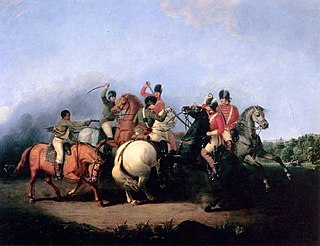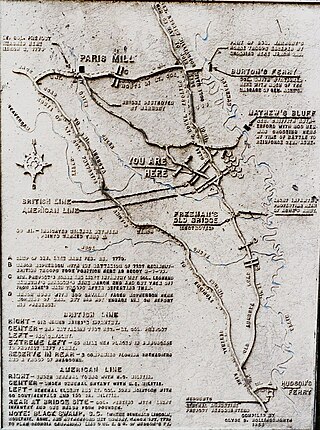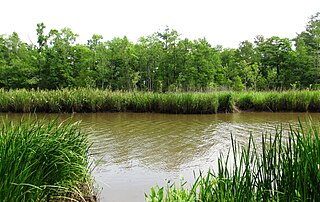Background
Following the defeat of General Horatio Gates’ Continental Army regulars by British forces at the Battle of Camden on August 16, 1780, organized military opposition to British occupation all but ceased in the South. [7]
In the aftermath of the British victory, armed Loyalist contingents of between 200-250 men were deployed to secure the countryside to suppress Patriot guerrilla activity, including that of General Francis Marion’s irregular fighting units. [8] On September 3, Marion and his 50-man mounted company attacked the Loyalist forces near the Little Pee Dee River, routing their 45-man advance guard. The next day at dawn, Marion’s men charged the Loyalist militia, drawing their 200 men into an ambush and dispersing them. [9] [1] [2] [5]
The British traveled across South Carolina, plundering and destroying Revolutionary properties. This prompted Marion to move into South Carolina, where Revolutionaries angered by the British action signed up in large numbers. Marion was alerted to the presence of Loyalists at Shepherd's Ferry, on the south side of Black Mingo Creek, then 15 miles (24 km) away. While the reports indicated that the Loyalist numbers were larger than his own, the enthusiasm of his men prompted him to agree to an attack. [1] [2] [5]
Battle
Marion had wanted to surprise the Loyalists with an early morning attack. The surprise was spoiled when, at nearly midnight, the lead horses in his column began crossing Black Mingo Creek via the wooden plank bridge 1 mile (1.6 km) downstream from the Loyalist Camp alerting camp sentinels. Alarm shots were heard in the Loyalist camp and British Colenel John Coming Ball mobilized his forces to repulse the rebel attatck.
Marion divided his small force into three groups sending them down the main road, and off to the right and left, surrounding the Loyalist troops. Ball formed up his men in a moonlit field adjacent to Dollard's Tavern, and ordered them to hold their fire until rebel fighters were within 30 yards (27 meters). The Loyalists, although greater in number, found themselves between two firing lines, gave way after just a few rounds and retreated into the swamp.
Although less than 100 men were engaged in the actual fighting that lasted maybe 15 minutes, Marion lost two men, including Capt. George Logan, and 8 wounded. The Loyalists lost three and 13 mortally wounded or captured. [1] [2] [5] [10] [11]
Marion confiscated Colonel Ball’s sorrel gelding as a personal prize, and rode the equine to the end of the war, after naming it “Ball.” [12]

The Patriot is a 2000 American epic historical drama war film directed by Roland Emmerich and written by Robert Rodat. The film stars Mel Gibson, Heath Ledger, Joely Richardson, Jason Isaacs, Chris Cooper, and Tom Wilkinson. Set in Berkeley County, South Carolina, it follows Benjamin Martin (Gibson), an American colonist who is opposed to going to war with Great Britain but, along with his son Gabriel (Ledger), gets swept into the American Revolutionary War when his home life is disrupted, and one of his sons is murdered by a cruel British officer (Isaacs). Rodat has said Martin is a composite character based on four historical men: Andrew Pickens, Francis Marion, Daniel Morgan and Thomas Sumter.

Brigadier General Francis Marion, also known as the "Swamp Fox", was an American military officer, planter, and politician who served during the French and Indian War and the Revolutionary War. During the American Revolution, Marion supported the Patriot cause and enlisted in the Continental Army, fighting against British forces in the Southern theater of the American Revolutionary War from 1780 to 1781.

The Siege of Charleston was a major engagement and major British victory in the American Revolutionary War, fought in the environs of Charles Town, the capital of South Carolina, between March 29 and May 12, 1780. The British, following the collapse of their northern strategy in late 1777 and their withdrawal from Philadelphia in 1778, shifted their focus to the North American Southern Colonies. After approximately six weeks of siege, Major General Benjamin Lincoln, commanding the Charleston garrison, surrendered his forces to the British. It was one of the worst American defeats of the war.

The British Legion was an elite British provincial regiment established during the American Revolutionary War, composed of Loyalist American troops, organized as infantry and cavalry, plus a detachment from the 16th Light Dragoons. The unit was commonly known as Tarleton's Legion, after the British officer who led it on campaign, Lieutenant Colonel Banastre Tarleton. It was a unit the size of a regiment, consisting of artillery, cavalry, and light infantry, and able to operate independently.
South Carolina was outraged over British tax policies in the 1760s that violated what they saw as their constitutional right to "no taxation without representation". Merchants joined the boycott against buying British products. When the London government harshly punished Massachusetts for the Boston Tea Party, South Carolina's leaders joined eleven other colonies in forming the Continental Congress. When the British attacked Lexington and Concord in the spring of 1775 and were beaten back by the Massachusetts Patriots, South Carolina Patriots rallied to support the American Revolution. Loyalists and Patriots of the colony were split by nearly 50/50.

The Battle of Moore's Creek Bridge was a minor conflict of the American Revolutionary War fought near Wilmington, North Carolina, on February 27, 1776. The victory of the North Carolina Provincial Congress' militia force over British governor Josiah Martin's and Tristan Worsley's reinforcements at Moore's was a turning point in the war; American independence was declared less than five months later.

The Battle of Fishing Creek, also called the Battle of Catawba Ford, was an American Revolutionary War battle fought on August 18, 1780, between American and British forces including the 71st Foot. It was fought near the junction of Fishing Creek and the Catawba River in South Carolina. British forces under Banastre Tarleton surprised the militia company of Thomas Sumter, killing a significant number, taking about 300 captives, and very nearly capturing Sumter, who some say was asleep at the time of the attack.
This article discusses the early history of Williamsburg County, South Carolina

The 84th Regiment of Foot (Royal Highland Emigrants) was a British regiment in the American Revolutionary War that was raised to defend present day Ontario, Quebec and Atlantic Canada from the constant land and sea attacks by American Revolutionaries. The 84th Regiment was also involved in offensive action in the Thirteen Colonies; including North Carolina, South Carolina, Georgia, Virginia and what is now Maine, as well as raids upon Lake Champlain and the Mohawk Valley. The regiment consisted of 2,000 men in twenty companies. The 84th Regiment was raised from Scottish soldiers who had served in the Seven Years' War and stayed in North America. As a result, the 84th Regiment had one of the oldest and most experienced officer corps of any regiment in North America. The Scottish Highland regiments were a key element of the British Army in the American Revolution. The 84th Regiment was clothed, armed and accoutred the same as the Black Watch, with Lieutenant Colonel Allan Maclean commanding the first battalion and Major General John Small of Strathardle commanding the second. The two Battalions operated independently of each other and saw little action together.

The southern theater of the American Revolutionary War was the central theater of military operations in the second half of the American Revolutionary War, 1778–1781. It encompassed engagements primarily in Virginia, Georgia, North Carolina, and South Carolina. Tactics consisted of both strategic battles and guerrilla warfare.

The Battle of Brier Creek was an American Revolutionary War battle fought on March 3, 1779, near the confluence of Brier Creek with the Savannah River in eastern Georgia. An American Patriot force consisting principally of militia from North Carolina and Georgia along with some Continental Army troops were defeated by British forces, suffering significant casualties. The rout damaged Patriot morale.

Griffith Rutherford was an American military officer in the Revolutionary War and the Cherokee-American Wars, a political leader in North Carolina, and an important figure in the early history of the Southwest Territory and the state of Tennessee.

The Battle of Blackstock's Farm, a military engagement of the American Revolutionary War, took place in what today is Union County, South Carolina, a few miles from Cross Anchor, on November 20, 1780.
Snow's Island is an area of swampy lowlands along the Pee Dee River in Florence County, South Carolina. The area is historically significant as the headquarters during the American Revolutionary War for forces led by Francis Marion (1732-1795), a South Carolina militia officer who is celebrated as the "Swamp Fox." Employing guerrilla war tactics, Marion significantly contributed to the American war effort by conducting numerous raids on British outposts." The site was declared a National Historic Landmark in 1974.
Jane Thomas was the wife of John Thomas, a colonel in South Carolina who fought for the rebels in the American Revolution. She passed key intelligence that thwarted an ambush of Whig forces.
Henry Mouzon II was a colonial-era American patriot and civil engineer. He prepared the definitive survey of the North and South Carolina Colonies prior to the start of the American Revolutionary War. He served as an officer of the Continental Line and as a militia officer in Francis Marion's Brigade, where he distinguished himself in the Battle of Black Mingo.
The Battle of Fishdam Ford was an attempted surprise attack by British forces under the command of Major James Wemyss against an encampment of Patriot militia under the command of local Brigadier General Thomas Sumter around 1 am on the morning of November 9, 1780, late in the American Revolutionary War. Wemyss was wounded and captured in the attack, which failed because of heightened security in Sumter's camp and because Wemyss did not wait until dawn to begin the attack.
The Battle of Tearcoat Swamp was a battle during the American Revolutionary War between Lieutenant Colonel Francis Marion's Patriot militia, and a Loyalist Militia led by Lieutenant Colonel Samuel Tynes. The battle took place on 25 October 1780 in present-day Clarendon County, South Carolina.
The Battle of Videau's Bridge was an engagement of the American Revolutionary War fought on January 3, 1782 in Charles Town District, currently Berkeley County, South Carolina. The British routed an American force opposing a foraging expedition they sent from Charleston. The British claimed to kill 57 and capture 20 Americans.

The Battle of Wambaw was an engagement of the American Revolutionary War fought on February 24, 1782 near Charleston, South Carolina.











